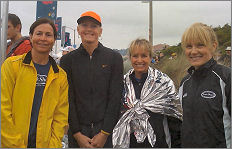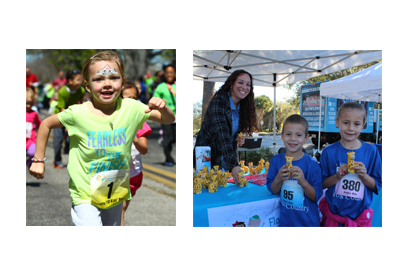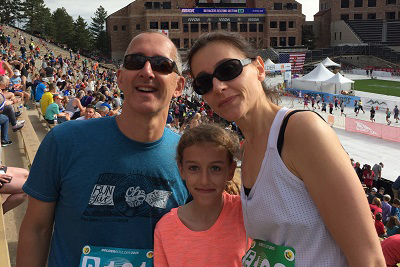Post-Marathon Recovery By Susan S. Paul, MS, TSF Training Program Director

What do you do now that your race is over? Runners are great at planning FOR the marathon: long runs, pace runs, track work, hills, easy days, hard days, tempo runs, etc. The details of every training run are meticulously logged into a running journal that includes the weather, heart rate, nutrition, sleep, mileage, the route, the quality of the run, etc. Attention to training detail is a good trait for any marathoner; yet, too many marathoners make the mistake of overlooking recovery as an essential piece of their overall training program. The recovery phase of marathon training is important, so take some time to plan your recovery phase before your marathon!
There is no exact formula for the recovery phase of marathon training. Some experts recommend one day of rest for every mile; that would mean 26 days of rest. Other experts suggest one day of rest for every kilometer, or 42 days of rest! Yikes! However, remember that “rest” does NOT mean NO running at all. “Rest” does mean a break from intense training like track work and racing. Most experts agree that post-marathon recovery takes a minimum of two to three weeks for the average runner. When planning your recovery phase, consider these aspects: 1) your fitness level going into the race 2) the difficulty of your marathon course 3) the temperature during the marathon, and 4) whether or not you “hit the wall”. All of these factors play an important role in determining how long it will take you to recover from your race. For example, if you are unprepared for your race your recovery will take longer. If the marathon course is difficult; ie, hills or is at altitude, your recovery will take longer. Your recovery will take longer when you race in warm temperatures than in a cooler climate. And, if you run out of stored energy and “hit the wall”, plan for a longer recovery time.
Recognize the significance of your achievement. Fast or slow, PR or not, disappointed or happy, you still ran 26.2 miles and need a recovery phase. Runners high off a good marathon performance often make the mistake of returning to training too soon. They regret it later when their running turns stale. Conversely, a poor marathon performance also can make some runners return to training too soon in an effort to improve their next performance. The lesson here is to PLAN YOUR RECOVERY PHASE BEFORE YOUR RACE! This way, no matter the outcome of your race, you will have a post-marathon recovery plan in place to follow.
Planning ahead of time for your recovery phase of training is the best way to ensure an adequate recovery period. Most runners are not comfortable with taking any time off from running and consider “rest” a four letter word. Just remember that “Rest” means taking a break from intense training, like racing and track work; it does NOT mean totally excluding running from your daily routine. Plan easy runs, incorporate some run/walk intervals into your run, run on trails, enjoy the scenery and leave your watch at home so you don’t turn an “easy” run into a race.
Light activity will actually help you recover faster than inactivity. This is a very good reason NOT to become a couch potato after your marathon. Exercise promotes circulation and circulation aids healing and recovery by delivering fresh oxygen and nutrients to your muscles. Take a walk, ride a bike, stretch, or swim for 20 to 30 minutes to promote circulation. The Recovery Phase is a good time to participate in activities you may have had to forego in preparation for your marathon. Try Yoga, Pilates, weight training, swimming, and/or spinning as an alternative exercise while you recover.
The Recovery Phase has two parts or purposes. Part One is actual recovery time. Plan to sleep in, eat, and pamper yourself for the first three days after your marathon. Then begin an Active Recovery Phase that includes light exercise and even some running. Part Two of recovery is establishing another goal. Marathoners need to recover mentally as well as physically, so focusing on another goal can be very helpful. What do you want to do next? A triathlon, speed work, more distance, another marathon perhaps? Take the time now to plan your next event.

The recovery phase begins the moment you cross the Finish Line. Keep moving and start drinking fluids right in the finish chute. Water and sports drinks are usually available, so pick them up and start drinking to begin replacing fluids, electrolytes, and glucose while you walk. Sudden stopping or lying down will cause a drop in blood pressure and may cause fainting, leg cramps, and nausea. If space blankets are available, take one; as you cool down you may need it. Make sure you pick up your medal and perhaps pose for a race photo!
The Port-O-Pottie may be your next stop- you should urinate within 6 hours of finishing the race, if not, consider contacting your physician as this would indicate serious dehydration!
Meet up with family or friends! It is best not to be left alone for the first 24 hours after the marathon just in case you should begin to feel bad. Make plans to have someone meet you near the finish line and accompany you for the next 24 hours. Pick up your gear bag and change into dry clothing as soon as you can.
Research indicates that refueling is best done immediately after exercise because your body is eager to absorb energy ….. so head directly to the post-race buffet! You have a license to eat! Your body replaces glycogen twice as fast as normal in the hour or two following the race. Pick up some bagels, bananas, yogurt, or any other easily digested high-carbohydrate foods provided by the race. As soon as your stomach can tolerate it, start eating.
Post-race massage at the race site can be very beneficial. Post-race massage should be a very light touch that simply helps re-direct blood flow up and out of the legs.
Note any significant aches or pains. Ice any potential injuries for a few minutes before beginning your trek home. Avoid stretching at this point in time because it may trigger muscle cramping; use slow, easy movements instead.
A long walk to your car or hotel room is not a bad thing; in fact, it may even help you! Easy, slow movement like walking is a nice cool-down and helps prevent muscle soreness and blood pooling in your legs. Before you begin your walk back though, make sure you have changed into dry clothes to avoid getting chilled!
Take an Ice Bath when you arrive home or back to your hotel room. Avoid a hot bath or the hot tub for 48 hours after the race! Cool water and icing will help minimize soft tissue inflammation and therefore aid your recovery. After your ice bath, plan on lying down with your feet elevated.
Eating a small meal that includes some protein is next on your recovery plan. Try a turkey or tuna sandwich. Small, frequent meals are tolerated easier than a large meal. Walking to dinner is another way to get in some more easy movement to help relieve muscle soreness. Continue icing any sore or inflamed areas.
PART ONE: The Second Phase- Day 2 to Day 21
After 48 hours, warm baths or the hot tub will help relieve muscle soreness. Light massage therapy can also be beneficial. Gentle stretching and light activity helps relieve muscle soreness by increasing the body’s circulation. Increased circulation removes waste products and replenishes muscle tissue with nutrients and oxygen. Drinking lots of fluids is also helpful in relieving soreness. It is best not to resume running until muscle soreness has disappeared.
Delayed Onset of Muscle Soreness (DOMS) typically follows most marathon efforts. The soreness results from microscopic muscle tissue damage. The severity of DOMS symptoms depends upon the fitness of the individual and the intensity of the effort. The degree of soreness indicates the extent of muscle damage and will influence the duration of recovery.
Heart Rate Monitoring can be a valuable, objective indicator of when to resume running and when to increase exercise intensity. Runners should measure their resting heart rate (RHR) during training on a regular basis to obtain a baseline RHR.
A resting heart rate that is 10 beats per minute or more above your normal pre-race resting heart rate is an indication of fatigue and incomplete recovery. When your RHR returns to normal you will know that you are ready to resume full training. If you don’t know your RHR, your breathing rate during running can help give you an indication as to the level of your recovery. If you sound or feel like you are racing a 5k during an easy training run, you will know that you are still fatigued and not ready to increase your exercise intensity yet. Continue with easy runs until your breathing rate and/or your heart rate has returned to normal.
PART TWO: MENTAL RECOVERY
Post-marathon blues affect many runners for several days to a few weeks following a marathon. Some scientists believe the central nervous system is simply exhausted after a marathon and this fatigue contributes to feelings of depression. Whatever the cause, adequate sleep, nutrition, hydration, and light exercise help alleviate some of the symptoms. Focusing on a new goal is also very helpful if you find yourself battling the blues. Whether it’s a 5k, a triathlon, another marathon, or even re-decorating the house, a new goal will help you deal with the post-marathon blues.
Assess your marathon performance. Take the time during the recovery phase to analyze your strengths and weaknesses. Where you well prepared for your race? Did your training match the demands of the race? Did you wish you had done more speed work, more hill work, or more long runs? Was your nutrition adequate? Determine where you want your training to go from here. Now is the time to address your weaknesses, know your strengths and capitalize on them in your next race.
Planning for your next marathon. Knowing your strengths and weaknesses will help you pick your next race. Do you want to travel? Does the temperature affect you? Does the time change affect you? Cool climate vs. warm climate? Do you like hills? Do you want a downhill course? A big city race with lots of spectators or a small race? Does the destination matter? Do you want to make a family vacation out of your trip? Are you looking for a PR race? Do you want a “fast” course to help you qualify for Boston? List your strengths, your weaknesses, and your goal for your next race and then begin searching for a match.
|
SAMPLE RECOVERY PROGRAM |
|
Most marathon training plans use a 3 week taper. One very easy recovery method is to plan a 3 week reverse taper to bring you back to running. |
Week 1
The first 5 days after the marathon are the most crucial to a good recovery. Give yourself permission to sleep in and eat. Easy swims, easy spinning or cycling, walking, and stretching are good activities at this time. You can include an easy run or some run/walk intervals for 2-4 miles on Day Six or Seven if no significant aches or pains are present. Measure your Resting Heart Rate. Total weekly mileage: 0-4 miles
Week 2
Measure your RHR. If it is less than 10 beats above your normal RHR, include easy runs of 2-4 miles 2-3 days this week. Use run/walk intervals if needed. Continue with other exercise activities too. If your RHR is 10 beats or more above normal continue with walking and light exercise activities other than running. Total weekly mileage: 4-10 miles.
Week 3
Measure your RHR; it should be returning to your pre-marathon baseline. If your RHR has returned to normal, include easy paced runs of 4-6 miles 3-4 days this week. Continue with swimming, stretching, and other activities. Total weekly mileage: 10-14 miles.
Use Facebook to Leave a Comment - We'd love to hear from you.







